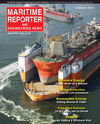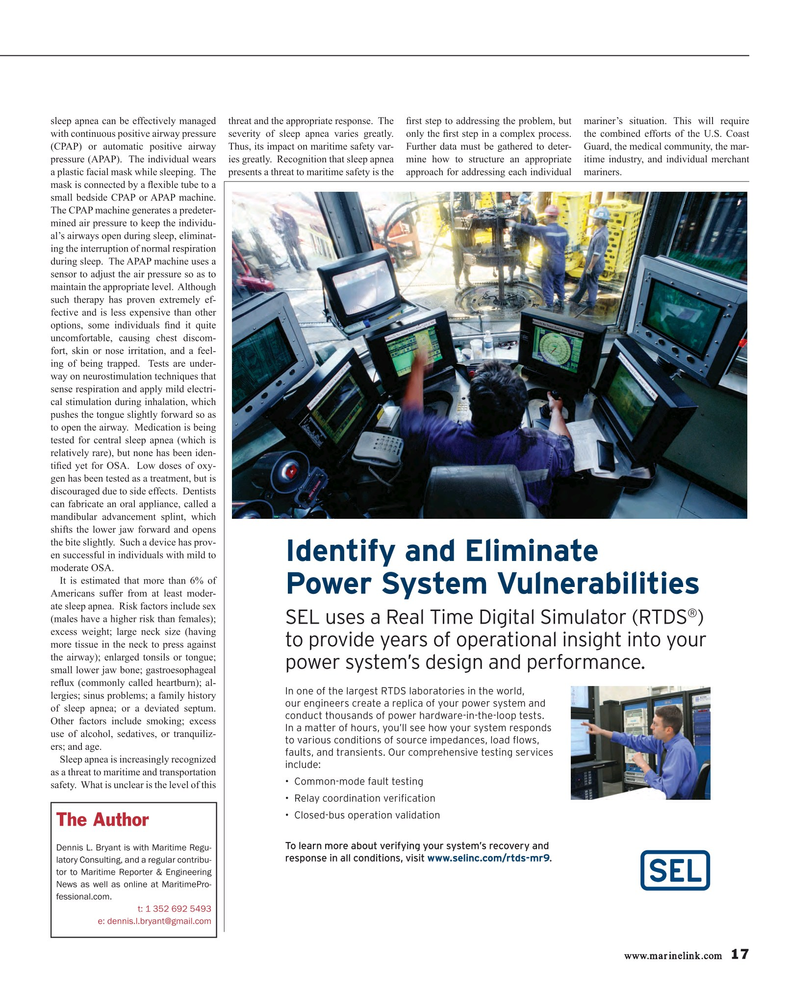
Page 17: of Maritime Reporter Magazine (September 2015)
Offshore Energy Technologies
Read this page in Pdf, Flash or Html5 edition of September 2015 Maritime Reporter Magazine
sleep apnea can be effectively managed threat and the appropriate response. The ? rst step to addressing the problem, but mariner’s situation. This will require with continuous positive airway pressure severity of sleep apnea varies greatly. only the ? rst step in a complex process. the combined efforts of the U.S. Coast (CPAP) or automatic positive airway Thus, its impact on maritime safety var- Further data must be gathered to deter- Guard, the medical community, the mar- pressure (APAP). The individual wears ies greatly. Recognition that sleep apnea mine how to structure an appropriate itime industry, and individual merchant a plastic facial mask while sleeping. The presents a threat to maritime safety is the approach for addressing each individual mariners. mask is connected by a ? exible tube to a small bedside CPAP or APAP machine.
The CPAP machine generates a predeter- mined air pressure to keep the individu- al’s airways open during sleep, eliminat- ing the interruption of normal respiration during sleep. The APAP machine uses a sensor to adjust the air pressure so as to maintain the appropriate level. Although such therapy has proven extremely ef- fective and is less expensive than other options, some individuals ? nd it quite uncomfortable, causing chest discom- fort, skin or nose irritation, and a feel- ing of being trapped. Tests are under- way on neurostimulation techniques that sense respiration and apply mild electri- cal stimulation during inhalation, which pushes the tongue slightly forward so as to open the airway. Medication is being tested for central sleep apnea (which is relatively rare), but none has been iden- ti? ed yet for OSA. Low doses of oxy- gen has been tested as a treatment, but is discouraged due to side effects. Dentists can fabricate an oral appliance, called a mandibular advancement splint, which shifts the lower jaw forward and opens the bite slightly. Such a device has prov- en successful in individuals with mild to
Identify and Eliminate moderate OSA.
It is estimated that more than 6% of
Power System Vulnerabilities
Americans suffer from at least moder- ate sleep apnea. Risk factors include sex ® (males have a higher risk than females);
SEL uses a Real Time Digital Simulator (RTDS ) excess weight; large neck size (having to provide years of operational insight into your more tissue in the neck to press against the airway); enlarged tonsils or tongue; power system’s design and performance. small lower jaw bone; gastroesophageal re? ux (commonly called heartburn); al-
In one of the largest RTDS laboratories in the world, lergies; sinus problems; a family history our engineers create a replica of your power system and of sleep apnea; or a deviated septum. conduct thousands of power hardware-in-the-loop tests.
Other factors include smoking; excess
In a matter of hours, you’ll see how your system responds use of alcohol, sedatives, or tranquiliz- to various conditions of source impedances, load ?ows, ers; and age.
faults, and transients. Our comprehensive testing services
Sleep apnea is increasingly recognized include: as a threat to maritime and transportation • Common-mode fault testing safety. What is unclear is the level of this • Relay coordination veri?cation • Closed-bus operation validation
The Author
To learn more about verifying your system’s recovery and
Dennis L. Bryant is with Maritime Regu- response in all conditions, visit www.selinc.com/rtds-mr9.
latory Consulting, and a regular contribu- tor to Maritime Reporter & Engineering
News as well as online at MaritimePro- fessional.com. t: 1 352 692 5493 e: [email protected] www.marinelink.com 17
MR #9 (10-17).indd 17 MR #9 (10-17).indd 17 9/4/2015 10:05:36 AM9/4/2015 10:05:36 AM

 16
16

 18
18
